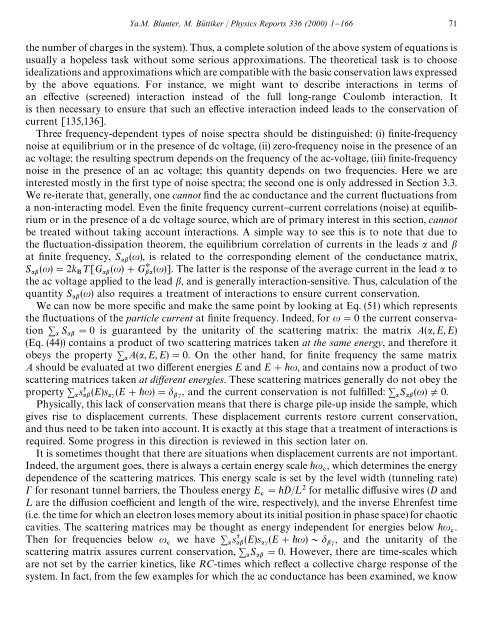shot noise in mesoscopic conductors - Low Temperature Laboratory
shot noise in mesoscopic conductors - Low Temperature Laboratory
shot noise in mesoscopic conductors - Low Temperature Laboratory
You also want an ePaper? Increase the reach of your titles
YUMPU automatically turns print PDFs into web optimized ePapers that Google loves.
Ya.M. Blanter, M. Bu( ttiker / Physics Reports 336 (2000) 1}166 71<br />
the number of charges <strong>in</strong> the system). Thus, a complete solution of the above system of equations is<br />
usually a hopeless task without some serious approximations. The theoretical task is to choose<br />
idealizations and approximations which are compatible with the basic conservation laws expressed<br />
by the above equations. For <strong>in</strong>stance, we might want to describe <strong>in</strong>teractions <strong>in</strong> terms of<br />
an e!ective (screened) <strong>in</strong>teraction <strong>in</strong>stead of the full long-range Coulomb <strong>in</strong>teraction. It<br />
is then necessary to ensure that such an e!ective <strong>in</strong>teraction <strong>in</strong>deed leads to the conservation of<br />
current [135,136].<br />
Three frequency-dependent types of <strong>noise</strong> spectra should be dist<strong>in</strong>guished: (i) "nite-frequency<br />
<strong>noise</strong> at equilibrium or <strong>in</strong> the presence of dc voltage, (ii) zero-frequency <strong>noise</strong> <strong>in</strong> the presence of an<br />
ac voltage; the result<strong>in</strong>g spectrum depends on the frequency of the ac-voltage, (iii) "nite-frequency<br />
<strong>noise</strong> <strong>in</strong> the presence of an ac voltage; this quantity depends on two frequencies. Here we are<br />
<strong>in</strong>terested mostly <strong>in</strong> the "rst type of <strong>noise</strong> spectra; the second one is only addressed <strong>in</strong> Section 3.3.<br />
We re-iterate that, generally, one cannot "nd the ac conductance and the current #uctuations from<br />
a non-<strong>in</strong>teract<strong>in</strong>g model. Even the "nite frequency current}current correlations (<strong>noise</strong>) at equilibrium<br />
or <strong>in</strong> the presence of a dc voltage source, which are of primary <strong>in</strong>terest <strong>in</strong> this section, cannot<br />
be treated without tak<strong>in</strong>g account <strong>in</strong>teractions. A simple way to see this is to note that due to<br />
the #uctuation-dissipation theorem, the equilibrium correlation of currents <strong>in</strong> the leads and <br />
at "nite frequency, S (), is related to the correspond<strong>in</strong>g element of the conductance matrix,<br />
S ()"2k ¹[G ()#GH ()]. The latter is the response of the average current <strong>in</strong> the lead to<br />
the ac voltage applied to the lead , and is generally <strong>in</strong>teraction-sensitive. Thus, calculation of the<br />
quantity S () also requires a treatment of <strong>in</strong>teractions to ensure current conservation.<br />
We can now be more speci"c and make the same po<strong>in</strong>t by look<strong>in</strong>g at Eq. (51) which represents<br />
the #uctuations of the particle current at "nite frequency. Indeed, for "0 the current conservation<br />
S "0 is guaranteed by the unitarity of the scatter<strong>in</strong>g matrix: the matrix A(, E, E)<br />
(Eq. (44)) conta<strong>in</strong>s a product of two scatter<strong>in</strong>g matrices taken at the same energy, and therefore it<br />
obeys the property A(, E, E)"0. On the other hand, for "nite frequency the same matrix<br />
A should be evaluated at two di!erent energies E and E#, and conta<strong>in</strong>s now a product of two<br />
scatter<strong>in</strong>g matrices taken at diwerent energies. These scatter<strong>in</strong>g matrices generally do not obey the<br />
property s (E)s (E#)" , and the current conservation is not ful"lled: S ()O0.<br />
Physically, this lack of conservation means that there is charge pile-up <strong>in</strong>side the sample, which<br />
gives rise to displacement currents. These displacement currents restore current conservation,<br />
and thus need to be taken <strong>in</strong>to account. It is exactly at this stage that a treatment of <strong>in</strong>teractions is<br />
required. Some progress <strong>in</strong> this direction is reviewed <strong>in</strong> this section later on.<br />
It is sometimes thought that there are situations when displacement currents are not important.<br />
Indeed, the argument goes, there is always a certa<strong>in</strong> energy scale , which determ<strong>in</strong>es the energy<br />
dependence of the scatter<strong>in</strong>g matrices. This energy scale is set by the level width (tunnel<strong>in</strong>g rate)<br />
for resonant tunnel barriers, the Thouless energy E "D/¸ for metallic di!usive wires (D and<br />
¸ are the di!usion coe$cient and length of the wire, respectively), and the <strong>in</strong>verse Ehrenfest time<br />
(i.e. the time for which an electron loses memory about its <strong>in</strong>itial position <strong>in</strong> phase space) for chaotic<br />
cavities. The scatter<strong>in</strong>g matrices may be thought as energy <strong>in</strong>dependent for energies below .<br />
Then for frequencies below we have s (E)s (E#)& , and the unitarity of the<br />
scatter<strong>in</strong>g matrix assures current conservation, S "0. However, there are time-scales which<br />
are not set by the carrier k<strong>in</strong>etics, like RC-times which re#ect a collective charge response of the<br />
system. In fact, from the few examples for which the ac conductance has been exam<strong>in</strong>ed, we know
















